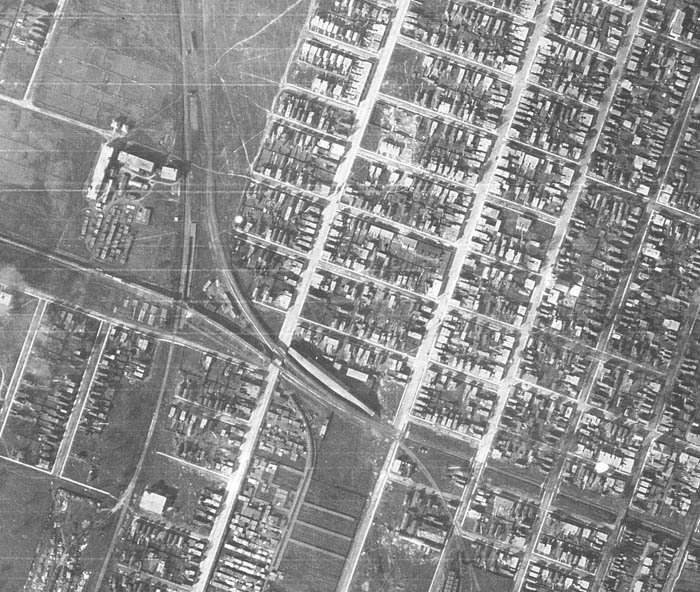Railway Tales in OVAR's Back yard
The Coal Trestle  The area was a wasteland until, in 1913, Mr. J.G. Butterworth, a coal merchant, wished to build rail served coal chutes to serve the area. He asked city council to sell him some waste land for the purpose and the city was happy to oblige – for $300. Mr. Butterworth then negotiated with the Grand Trunk Railway(GTR), predecessor to the Canadian National, for the provision of a siding to bring in his coal. For this he would need a crossing at grade over Rochester Street which would require the blessing of the Board of Railway Commissioners. Area residents voiced their objections as did city council. (It seems rather ironic that the city would sell Butterworth the land he needed then object to his gaining access to it). The story now becomes a little confused. It was suggested that a keg of beer would satisfy the neighbours’ objections. This was vigorously denied by Butterworth who claimed he would maintain the fight until such time as the objectors could no longer afford to continue. There was also the suggestion that $50 had changed hands. It was claimed that this was merely to cover the costs of a lawyer retained by those objecting if they agreed to withdraw. The matter went before the Board of Railway Commissioners (BRC) and Assistant Commissioner Scott gave judgment. The board, he said, was not concerned with what use Mr. Butterworth might make of his properly, and there was no reason why the application for a spur line shouldn't be granted. There were already two tracks already across Rochester street, and the additional one would be used only for slow movements. He authorized the application on condition that all trains be flagged. BRC Order 19415 of 26 May 1913 authorized the GTR to construct a branch line or siding and spur commencing on its Chaudiere Branch west of Division Street, and extending westerly crossing Rochester Street and Mark Street (unopened) into the premises of J.G. Butterworth in Block 183, Ottawa. The crossing of Rochester Street to be protected by a watchman who will flag all movements of locomotives and cars over the crossing. Branch line and spur to be constructed within 3 months. And so the Butterworth Coal Company began to serve the area. Hall Fuels took over the operation in 1935. The chutes covered almost the entire distance between Rochester and Preston streets. There were 22 hoppers which were supplied by gravity from rail cars above. This all came to an end on the night of 26 June 1956 when the coal chutes caught fire. Witnesses said the fire leaped up at the east end of the wood frame structure and swept its 350-foot length in three minutes. In all eighteen of the 22 coal hoppers were destroyed as well as four empty coal cars that had recently been unloaded. They had been left standing on the upper loading trestle on the roof of the structure. In all some 2,000 tons of coal and coke were consumed. The origin of the fire was not known although there had been several grass fires reported in the vicinity a few days before. The original objections from neighbours became a reality when five houses were threatened by fire as well as the gasoline tanks of the Ottawa-Toronto Motorways company which was forced to move away several of its vehicles. Flying debris caused small fires to break out in the French Lumber Company yard but these were quickly extinguished by firefighters. At its height the flames soared to 160 feet and could be seen from as far afield as Uplands airport, Eastview and the Connaught Raceway. The damage to the houses was mainly from smoke and water but local residents opened their homes to the displaced families. In all, some 40 firefighters worked the blaze which was brought under control within a couple of hours. Fireman James Butler was treated for smoke inhalation at Civic Hospital and later allowed to go home. The police had a tough time controlling the crowd of 5,000 which turned up to watch the blaze. The crowd was orderly most of the time. However, several hundreds who walked or were pushed too close came under the hoses accidentally on at least two occasions. An eastbound CNR freight train was delayed briefly but allowed through when the danger of flames spreading abated. Hall Fuels talked about rebuilding but were able to continue serving the area from another facility at Broad Street nearby. The Federal District Commission (now NCC) were already looking at removing the CNR cross town tracks to make was for the Queensway so the long term future for rail service was in significant doubt. So the next time you walk out to your car think back to the time when the whole area was an enormous pile of glowing coal Ottawa Valley Associated Railroaders Interchange September 2019 |
